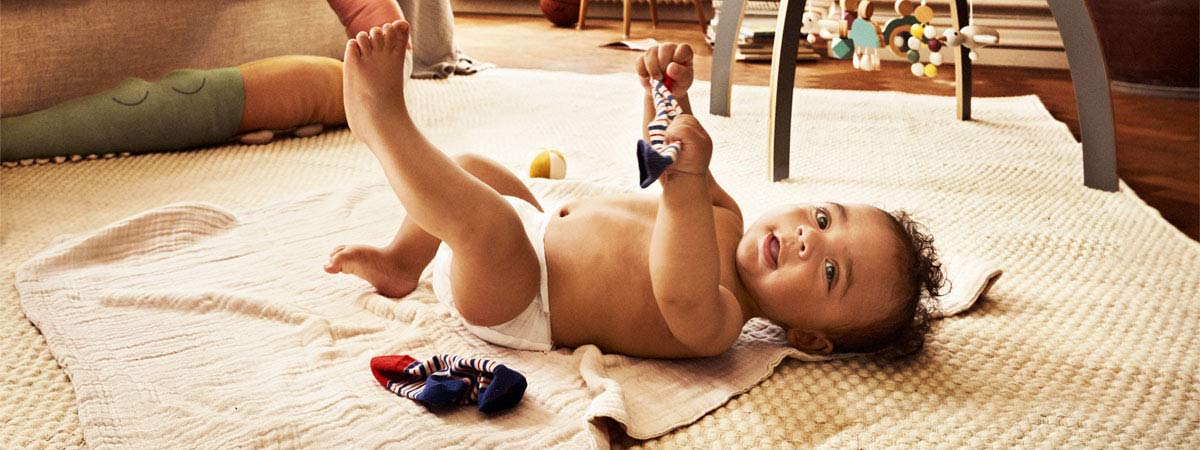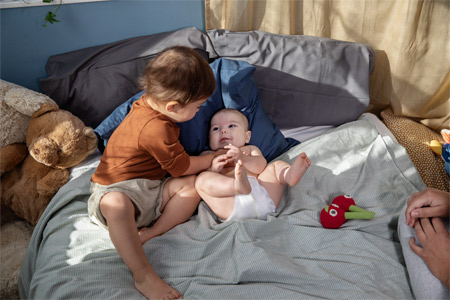Baby’s development: 6-18 months
Crawling, sitting and walking – most babies start to figure out how to control their bodies and move on their own by 18 months. But babies tend to want to do different things: some are bouncing around by a year old; others spend all their energy refining the pincer grasp. Here, we’ll go through babies’ development from 6 months up to 1.5 years.
Once your baby passes the 6-month mark, quite a lot happens in their life. Baby’s balance improves; their hands are working together better; they’re more aware and more curious; soon, your baby will be able to move around on their own. As a parent, you will likely be amazed at how much your little one is learning. Of course, children develop at different paces, and it can be nice to know that your paediatrician will be monitoring your baby’s development – just to offer extra support early on if needed. You can also contact your paediatrician in between visits if you’re wondering something about your child’s development.
Picking things up with the pincer grasp
Baby’s fine motor skills have started to develop, and a 6-month-old can often grasp objects with both the right and left hand. Around 10 months, the so-called pincer grasp starts to develop, which is use of the thumb and index finger to pick up an object. You won’t know whether your child is right or left-handed yet, because they tend to use both hands more or less equally and with equal skill. A preference for one hand over the other will start to appear around one year. At 1.5 years old, most children have such good control of their hands that they can eat with a spoon, drink from a cup, and stack a few blocks into a tower.
Sitting without support
Most 6-month-old babies still need back support when sitting, but the more stable they become, the longer they can sit on their own – and eventually, without support. The best way to train these muscles is through practice, but watch that they don’t sit still for too long; that would be a lot of work for the back – which, relative to the body, does indeed have to hold up quite a large head.. Around 10 months, most babies can sit all on their own, without support.
Tummy time is fun
At 6 months, most babies tend to prefer to lie on their tummies to explore the world, and those who haven’t learned how to roll around yet will learn soon. Babies at this age often like to move like a clock while lying on their tummies: they’ll spin around and reach for things they couldn’t get to before. The first real movement will also likely occur from the tummy. But contrary to what you might think, they probably won’t be going forward. In fact, most babies usually start by learning to scoot backward. In their eagerness to go forward, babies tend to push with their arms which, perhaps somewhat annoyingly, has the opposite effect. The next step in this process is to learn to use their legs at the same time, to move forward and up.
When do babies start to crawl?
Some babies are able to come up to all fours for quite a long time before they start to crawl, while others figure out more quickly how to start putting one knee in front of the other in order to move forward. Some begin as early as six months – others find this less interesting and wait a few months more before they take interest in learning to crawl. Try not to stress out; let your baby take their time. Once this skill starts falling into place, be aware that babies need to move a lot to stimulate their crawling movements. So once they figure out how to come up to all fours, it’s not a bad idea to let them do so as much as they want. It’s common for babies to get frustrated and angry when they want to crawl, but can’t manage to get anywhere – this is an entirely natural part of the process. Rest assured that their mood will settle back down once they’ve started to figure out how their arms and legs can work together. It might also be good to know that far from all babies think learning to crawl is worthwhile. Some get so good and so quick at scooting that they aren’t really motivated to start crawling. Instead, they’ll skip that step and go straight from scooting to walking.
One thing that often happens as your baby learns to bop about on their own is that they can get a little more anxious and have a greater need for comfort. That’s mostly because for a 7–8-month-old baby, the world just got a lot bigger. Their ability to take in their surroundings has just gotten much better, and they can also move around physically now– so of course it might be super scary when a tiny tot manages to crawl around a corner and suddenly can’t see their parents or understand where they’ve gone. But separation anxiety is also a part of development that it’s good to be aware of. Sleep can be affected at this point, too: a baby who has just passed six months may very well start sleeping poorly. The best trick is simply to offer as much closeness as you can – and remember that this phase will pass.
Standing up with support – and cruising along the furniture
Once your baby has figured out the easiest way to move around by crawling or scooting, the next step is to stand. As with all other motor skill development, when this happens varies from one child to the next. Standing up at six months is fairly early; it will usually take another couple of months. They rarely learn to stand up all by themselves: at first, they usually pull themselves up, using either the furniture or your trouser leg for support – this is a good time to wear a belt. After a little practice pulling themselves up, babies usually quite naturally try to stand on their own. Those first assisted steps usually come next, as they manage to cruise sideways along the furniture or something else at the proper height that they can hold onto. Your baby will probably still prefer to crawl or scoot for a while more, because it’s a much faster and more efficient way to get around.
Learning to explore and discover their surroundings
Babies learn a ton by getting to explore their big little world. Opening cupboards, looking in drawers, touching things and exploring their surroundings under the supervision of an adult – that’s the best way to learn. One tip is to move anything fragile as well as small and sharp objects out of the lowest drawers in the kitchen – and then let your baby go nuts. Getting to find – and take out – different kitchen tools, like mixing bowls, ladles and plastic cups, is super exciting, stimulating and very fun for a one-year-old. Putting it all back again might not be a one-year-old’s strongest suit, but it is something an adult can show them how to do.
When do babies start to walk?
Most babies take their first steps somewhere between 12–15 months, though some are earlier and some are later. It’s easy to be a little worried about all those thumps and bumps in the beginning, but falling is a natural part of development. Babies are made to last for at least 80 years and in fact, tots who have just learned to walk fall about 17 times per hour – so let those little bumps be a reminder of their resilience. You can offer a little support behind them at first, but once they’ve understood the principle, it’s best to just let them try to stand up without interfering, because you learn by trying things yourself.
Babies around1.5 years or older usually walk quite stably, but of course, that depends on when they start teetering around. Like most things, walking is a skill that requires practice. Many babies can also squat down and stand up without support at this stage, and some already have their sights set on learning how to run.
Please note that all information above is based on Swedish recommendations.



